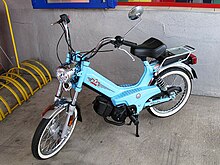Puch Maxi
The Puch Maxi is a moped that was manufactured by Steyr Daimler Puch and later by Piaggio . The Maxi was designed by Louis Lucien Lepoix .
The Maxi models were built between 1969 and 1995. However, the models built from 1991 are called LG1 and LG2. The Puch Maxi was the last Puch moped to be built before the moped and bicycle production was sold to Piaggio. A typical feature of the Maxi is the tank that is already integrated in the frame, and the Maxi N model also has a rigid frame without rear suspension.
prehistory
Two-wheeler expert Friedrich F. Ehn calls the Puch X 30, as it was manufactured for Switzerland in 1962, as a direct Maxi forerunner, which was completely different from the older Puch MS 50 in terms of construction. The MS 50 from 1954 (called: "Stangl-Puch", "Postler-Moped", "Shiftler-Moped", "Maurer-Bock", "Schwarze Sau") was the successful constructive step in the gap between bicycles with auxiliary engines and the motorcycle . This development was preceded by the “Styriette” of 1938/1939 in the Puchwerk .
Sport and fun
Since the old master Johann Puch became a manufacturer, racing success has been a central theme for producers and the public. But active racing is denied to most people for cost reasons alone. It was definitely not in the specifications of designer Lepoix that the Maxi race is driven .
The inexpensive mass basis of the Maxi led on the one hand to customizing for show purposes, on the other hand to modifications for racing use on asphalt and off-road. The Austrian “Zweirad Club Bist du Moped” is an example of racing with the Puch Maxi.
Formations like the " en: Moped Army " strive for style-defining positions. The private screwdriver scenes have long since been joined by providers such as "1977mopeds".
Popularity and spread
The Maxi can also be found in everyday life across Europe at the beginning of the 21st century, from the Balkans to the Nordic countries . The 1990s Maxis, like the XL P1, are - due to the times - not described in the standard literature by Ehn and Verwüster. In Austria the moped has long been known as a special type of moped and the product name “Puch Maxi” in its short form “Maxi” is taken for a separate vehicle category, often also applied to other makes.
What is known as a “motor-assisted bicycle” or “small moped” in English-speaking countries, for example, is still brand new in stores in Austria in the form of its southern Slavic offshoot Tomos . Maxis are omnipresent on Austria's streets. Occasionally as the “sister model” of KTM , the “KTM Hobby”, which was partly also equipped with the successful one-way automatic (internal company name E50) and two-speed automatic (ZA50) engines from Puch.
Models
- Automatic motors (E50)
- Puch Maxi
- Puch Maxi L.
- Puch Maxi N
- Puch Maxi S (Sport)
- Puch Maxi E.
- Puch Maxi P
- Puch Maxi K (Kickstarter)
- Puch Maxi GS (off-road sport)
- Puch Maxi S.
- Puch maxi Tsch
(Sales designation L)
- Puch Maxi S.
- Puch Maxi GS
- Puch Supermaxi LG 1
- 2-speed automatic motors (za50)
- Puch Supermaxi LG 2
- Puch Maxi S 2a (sales name L2)
- 2-speed motors (Z50)
- Puch Maxi 2
- Puch Maxi N 2
- Puch Maxi S 2
- Puch Maxi E 2
- Puch Maxi S 2
- Puch Maxi 2K
- Puch Maxi GS 2
- Puch Maxi Custom
- Special models
- Puch Maxi N Chopper (automatic motor)
- Puch Maxi Nostalgie (automatic motor, Maxi-S frame, only built in 1976)
- Puch Maxi Sport (automatic motor, long bench, luggage rack with reflectors on the sides)
- Puch Maxi N DGR (automatic motor, die-cast wheels)
- Puch Maxi Plus (automatic motor)
- Puch Maxi Sport DGR (automatic motor, die-cast wheels)
- Puch Maxi Super S (automatic motor, white paint, lamp mask)
- Puch Maxi N Off Road (automatic engine, off-road version, different fork, different mudguard)
- Puch Mini Maxi (automatic motor, small rims)
- Puch Maxi 2 (2-speed motor)
- Puch Maxi Turbo Sport (4-speed foot switch)
- Puch Maxi Casablanca (was only built 1972–1973)
- Puch Maxi Strada (Puch Maxi N with cat.motor)
Technical specifications
| model | Puch Maxi N (1985) | Puch Maxi S (1978) | Puch Maxi S2 | Puch Maxi N2 |
|---|---|---|---|---|
| engine | 1-speed automatic engine Puch E50 | 2-speed shift motor Puch ZA50 | ||
| cylinder | 1 | |||
| Displacement | 48.8 cm³ | |||
| power | 0.8 kW (1.2 PS) at 4000 rpm | |||
| Top speed | 25 km / h (in Germany), or 30 km / h (in Switzerland), or 40 km / h (in Austria) | |||
| Transmission gears | 1 automatically | 2 automatically | ||
| fuel | Regular petrol 1:50 | |||
| consumption | 1.5 l / 100 km | |||
| Tank capacity | 3.2 l | |||
| Empty weight | 44 kg | |||
| maximum weight allowed | 130
Kg |
|||
| Seats | 1 or 2 | |||
| Others | Has no rear suspension | With rear suspension | With rear suspension and 2-speed motor | Without rear suspension, with a 2-speed motor |
| Original pinion (motor / rear wheel) | 13/45 | 13/45 | 18/45 | ? /? |
literature
- Friedrich F. Ehn: The great Puch book. Puch two-wheeler production from 1890–1987. 8th edition. Weishaupt, Gnas 2013, ISBN 978-3-900310-49-3 .
- Wolfgang J. Verwüster: Puch. Mopeds, scooters & mopeds. Weishaupt, Gnas 2007, ISBN 978-3-7059-0254-1 .
Individual evidence
- ↑ http://www.bistdumoped.at/ (queried on April 14, 2013)
- ↑ http://www.1977mopeds.com/ 1977mopeds (queried on April 14, 2013)
- ↑ Friedrich F. Ehn: The great Puch book. Puch two-wheeler production from 1890–1987. 7th edition. Weishaupt, Graz 2008, ISBN 978-3-900310-49-3
- ↑ Wolfgang J. Verwüster: Puch. Mopeds, scooters & mopeds. Weishaupt, Gnas 2007, ISBN 978-3-7059-0254-1
- ↑ Technical data sheet for the N version dated May 8, 2009, 8:26 pm
- ↑ Technical data sheet for the S version from June 14, 2009, 10:12 pm
Web links
- http://www.oldiemofa.de/html/body_puch_1985.html - specifications of the most common Maxi models and a table of technical data








